KOBE EARTHQUAKE OF 1995
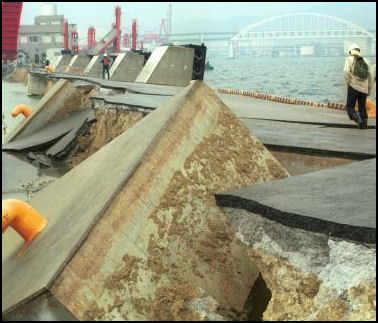 The earthquake in Kobe on January, 17, 1995 left 6,425 dead, injured 25,000, displaced 300,000 people, damaged or destroyed 100,000 buildings and caused at least $132 billion worth of damage, or about 2.5 percent of Japan’s national income, making it one of the most expensive natural disasters in history. Only about $3 billion was covered by insurance.More than 35,000 people were pulled from collapsed buildings by neighbors or rescue workers. Japanese refer to the disaster as the Great Hansin Earthquake. [Source: T.R. Reid, National Geographic, July 1995]
The earthquake in Kobe on January, 17, 1995 left 6,425 dead, injured 25,000, displaced 300,000 people, damaged or destroyed 100,000 buildings and caused at least $132 billion worth of damage, or about 2.5 percent of Japan’s national income, making it one of the most expensive natural disasters in history. Only about $3 billion was covered by insurance.More than 35,000 people were pulled from collapsed buildings by neighbors or rescue workers. Japanese refer to the disaster as the Great Hansin Earthquake. [Source: T.R. Reid, National Geographic, July 1995]
Beginning at 5:46am, the temblor lasted for 20 seconds, registered 6.9 on the Richter scale and packed a wallop of 240 kilotons of TNT. Over 50,000 buildings were destroyed or badly damaged and 300,000 people were left homeless. A major freeway collapsed, streets were uplifted, and railroad tracks buckled and twisted. Fire raged on and off for two days, and gas and water mains were ruptured.
The earthquake was the worst in Japan since the Great Tokyo Earthquake in 1923, when a earthquake measure 7.9 on the Richter Scale killed 140,000 people, and the greatest disaster in Japan since World War II. It was caused by a strike-slip jolt (sudden lateral movement of one rock mass against another) on the Nojima Fault, which up until then was not considered a dangerous fault.
The epicenter of the earthquake was 40 miles away from Kobe in the Akashi Straight between Awaji Island and Honshu. During the quake the sides of the fault shifted 6 to 10 feet in opposite directions. The surface along the fault moved five feet in one place. This movement could be seen in a rice field on Awaji Island.
There were several reasons why the earthquake was so devastating. First of all the earthquake was very shallow, which means it is more likely to cause extensive damage. Second, Kobe lies in area that many Japanese thought was unlikely to be hit by a major earthquake and thus th residents there were not prepared for a major quake. Kobe is considered one of the nicest cities in Japan and ironically some people even moved there to escape earthquakes.
See Separate Articles:EARTHQUAKES AND JAPAN factsanddetails.com ; EARTHQUAKES: GEOLOGY, FREQUENCY, TYPES, ENERGY AND RESEARCH factsanddetails.com ; LARGE EARTHQUAKES IN JAPAN factsanddetails.com ; GREAT TOKYO EARTHQUAKE OF 1923 factsanddetails.com ; MAJOR EARTHQUAKES IN JAPAN IN THE 2000s factsanddetails.com
Good Websites and Sources: Kobe Earthquake Digital Material Collection lib.kobe-u.ac.jp ; Kobe Earthquake Site seismo.unr.edu ; Wikipedia Wikipedia ; Earthquake Image Archive geot.civil.metro-u.ac.jp ; Medical and Public Health Response to the Kobe Earthquake pdf file ippnw.org/MGS ; Insurance and the Kobe Earthquake pdf file u-tokyo.ac.jp/cemano/research ; Kobe Earthquake Restoration kkr.mlit.go.jp ; Book: “After the Quake” (Knopf, 2002) by Haruki Murakami is a collection of stories related to survivors of the Kobe earthquake in 1995. Kobe City: Official Kobe Tourism site feel-kobe.jp Hyogo Prefecture site hyogo-tourism.jp ; Map: Japan National Tourism Organization JNTO ;Official Kobe Tourism site feel-kobe.jp ;
Kobe Earthquake Death and Damage

Nearly 80 percent of the quake victims died from being crushed or suffocated in collapsed buildings. Shoddy construction and poor planning were blamed for the death toll being so high. Many people were killed when heavy typhoon-resistant tile roofs collapsed on top of them.
Sixty percent of those who died were over 60 years old. The reason for this is that they were mainly the one who lived in the older houses that collapsed. Few people died in new homes. Nearly all the buildings that killed people were built before the enactment of modern building codes in the 1970s and 80s. Many newer buildings were badly damaged but they didn’t collapse.
In Kobe Earthquake took place before 6:00am, while many people were still asleep. Many bodies therefore were found at or near their homes, and this helped in the identification of more than 5,000 bodies in only about 10 days. After the original 5:46 a.m. quake, those that survived went back into their homes to search for family members, remove their valuables, or otherwise clean up. Many were killed when a second quake hit a couple of hours later, being trapped in their already weakened structures.
The damage was very spotty. Some neighborhoods were totally destroyed while others nearly were untouched. Some new houses were badly damaged while some old ones were undisturbed. The reasons depends on a number of factors including construction methods, maintenance, soil stability, and location of gas lines. Damage in nearby Osaka and Kyoto was relatively minor.
In the 1995 Kobe Earthquake, the subsequent deaths of about 920 people days and weeks after the disaster, or about 14 percent of all victims, were recognized as being caused by the earthquake.
Kobe Earthquake Survivor Stories
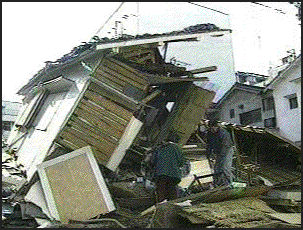
As bad as the earthquake was 99.9 percent of the people in the stricken area survived. One woman told the New York Times: "I am a heavy sleepper, and when I woke up, half my furniture was on top of me. Luckily I don't have much furniture, so I was able to wriggle out from under it.
One woman who was sleeping with her daughter told the Washington Post: "The second floor and a neighbor's house all crashed on us. [My daughter] was so unfortunate to be sleeping beside me. Debris fell on her and it was impossible to get her out." All the woman could find was her daughter's hand sticking out of the rubble. "Her hand was warm, but she couldn't speak. I was trying to keep up her strength, but I could feel her getting weaker. I kept holding her hand, and gradually it turned cold."
A couple told the Washington Post that when the earthquake stopped the ceiling of his house was a foot over his head. "We were holding onto each other. The trembling went on and on and then stopped. Then we noticed that all the furniture was in disarray.” After six hours they were freed by rescuers who chopped through the ceiling above them.
One woman who stood by a neighbors house' while it was engulfed by flames told the New York Times, "We could here him call out. 'Help me,' he shouted. 'Help me.' But we couldn't do a thing. We just had to stand there."
One Kobe survivor who lived in a two-story wood house that collapsed told the Yomiuri Shimbun, “All five members of my family were buried alive. We were sleeping on the first floor. Everybody, except Kazuhiro, was rescued by the evening. But, there was no responses from Kazuhiro no matter how much I called to him. When he was finally found, his body was already cold...Kazuhiro might have been hit in the head by the piano. He was sleeping by the piano.”
Kobe Earthquake Infrastructure and Building Damage
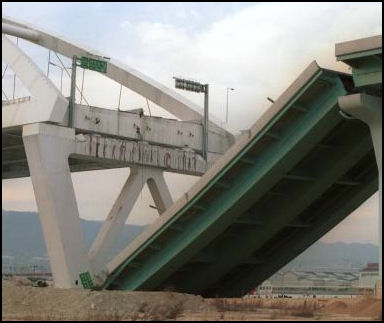
Kobe's port, which handles 12 percent of Japan's exports, sunk as much as 10 feet and was shut down except for emergency use; and the Hanshin Expressway, between Osaka and Kobe, shook, twisted sideways and collapsed on its side in five places, including one 550-yard section that killed 12 people in cars when it toppled over on its side.
Railroad cars weighing 65,000 pounds were tossed on the roofs of buildings. Bullet trains lines were damaged in 36 places over a length of 56 miles, requiring three months to fix. The collapse of the 550-foot section of Hanshin Expressway wake blamed on lack of steel reinforcements. Supports with ample amounts of vertical steel rods remained intact while those made with a higher percentage of concrete collapsed.
There were hundreds of fires, many ignited by toppled gas cookers and kerosene stoves. Fire raged unchecked in several places. Firemen were unable to do anything to stop them because there was no water, and the fires spread rapidly because of strong winds. In some case Residents tried to put out fires using sewer water while firefighters stood by with water dribbling out of their hoses from lack of pressure. The disaster could have been worse had it been a few hours later when more shops were open and more people were cooking with kerosene stoves.
About a million of Kobe's 1.4 million residents lost their electricity, gas and water supplies due to damaged pipes and transmission lines. Underground pipes were so badly damaged that thousands of people were still without gas, three months after the disaster. Phones in twisted and toppled phone booths continued to work.
Tall building remained standing while many small houses were destroyed. The most vulnerable structures were traditional wood frame-and stucco houses built after World War II, many of which collapsed "as if they were made of matchsticks."
Kobe's modern buildings "seemed to have performed very well," a former Stanford engineering professor told Newsweek. "There may have been one or two that have been damaged. But I haven't heard of any that fell." Every building constructed according to the building codes established in 1981 was unscathed.
Survivors After the Kobe Earthquake

In the days that followed the earthquake many survivors carrying their possessions in backpacks and suitcases walked or robe bicycles to the nearest train stations with working trains, about ten miles from downtown Kobe. Major roads were blocked with debris and took some time to clear. People died and houses burned because ambulances and fire trucks were stuck in a 20-mile traffic jam eon the main Osaka-Kobe highway couldn't get to them in time.
Even though there were rumors to the contrary and goods were available for the picking in the shattered store windows there was little or no looting in Kobe. Jewelry stores were unprotected yet no one took anything. People waited patiently in lines with the only arguments coming from people who insisted that others go before them.
Survivors pitched tents and slept in them in turn, because there weren't enough to go around. Latrines were built and campfires were lit for warmth and cooking. More than 300,000 people were moved to emergency shelters in schools, gymnasiums and other buildings, where they slept like packed sardines on floors and even on the stairs.
Food was scarce for the first two days, when some Kobe residents fought over packets of noodles. One survivor in an emergency shelter told a Japanese television station, "we haven't eaten anything except one or two slices of bread and a banana — that's all today. Thirsty survivors spooned up dirty water from underneath ruptured pipes. In one area 1,000 refugees were given 1000 rice balls to divide among themselves and nothing to drink. One refugee told a Japanese newspaper, "The authorities haven't done anything. If we continue to rely on them we'll starve to death.”
Unprepared for the Kobe Earthquake
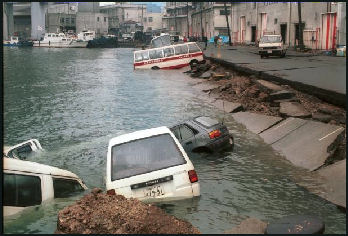
Prime Minister Tambac Murakami did not know about the earthquake until he watched the morning news on television. An order to send in the military was not issued until nine hours after the quake and horrendous traffic jams delayed them an additional five hours. Firefighters watched houses burn to the ground because they had no water and trucks with food and water were sent late and also delayed by the traffic. The Japanese government also refused help from the U.S. military, which could have provided an aircraft carrier with a 2,000-bed medical facility.
Few fiber optic cameras were used to locate survivors in the rubble. In some cases search dogs were not deployed until three days after the quake. No on-sight medical treatment was available. "All they seem to have are a bunch of chain saw and shovels," one California rescuer told Newsweek.
Experts believe that one of the first thing the Japanese government should have done was make sure the roads were clear so rescuers, emergency equipment and firefighters could make their way to the city. A professor at Tokyo University told the New York Times: "This earthquake symbolizes the systematic weak points in our postwar system. There is no systematic flexibility. This kind of rigidity in our system is proved by this enormous tragedy. When something disrupts our system, the system becomes unworkable." Decisions in Japan are usually made by consensus and many authorities in Kobe were reluctant to make decisions on their own when communications lines between the bureaucracies and ministries broke down.
The Japanese were highly critical of the American response to the North ridge earthquake near Los Angeles in 1993. After that ridge quake, however, all the fires were put with eight hours and no one was caught in rubble for more than eight hours, while Kobe some victims died because their bodies were not pulled out until five days after the quake.
Some people were taken care of better by the yakuza than by the government. After the quake, Kobe-based Yamaguchi-Gumi, largest organized crime groups in Japan, provided mineral water, powered milk, fresh eggs, bread and diapers to thousands of quake victims. Meals were given out in the parking lot next to Yamaguchi-Gumi headquarters at a rate of 8,000 a day "The operation," reported the New York Times, which was "said to be efficient than the Government's, has been a source of pride for the gangsters."
Media Coverage of the Kobe Earthquake
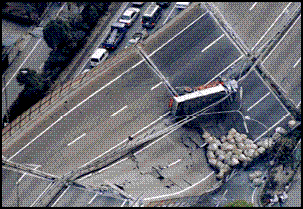
Japanese TV shot The Japanese and Western coverage of the earthquake was quite different. Upon visiting Kobe after watching coverage on Japanese TV one Washington Post reporter said, "I was just stunned at the extent of the damage.” A reporter who had just arrived from the U.S., where he had been watching American network coverage of the disaster said, "My first reaction was 'Wait a minute!' There's still a skyline!" [Source: Washington Post]
The Japanese media was not as intrusive as the Western media. After Japanese television reporter asked an earthquake survivor, "Don't you feel cold?" the network he worked for received a number of calls complaining that the reporter had "unduly invaded the survivor's privacy.” [Source: Washington Post]
A columnist in a Korean newspaper wrote that the calm, orderly behavior of the Kobe victim just goes to show that the Japanese were "automatons." Later, when it became clear that Korean victims in Kobe were receiving the same treatment as Japanese, the columnist changed his tune and wrote that the Japanese have "amazing power of self-discipline, perseverance and solidarity."
Kobe Gets On Its Feet After the Earthquake
A week after the earthquake most people were back at work. Salarymen walked past eight foot piles of rubble and thousands of homeless sleeping on tent cities. Merchants who lost their stores, set up stalls outside their ruined shops. The three railroad companies that serviced Kobe announced that service had been restored. Sort of. [Source: TR. Reid, Washington Post]
Most of the highway that toppled over was removed in six days. Full railway service was restored in Kobe less than four months after the earthquake, a month ahead of schedule.
Because Kobe is such an important port, exports dropped 5 percent a month that followed the disaster. But increased use of other ports and round-the-clock repair work quickly returned trade to pre-disasters levels. Large national companies weathered the disaster relatively unscathed by coming up with alternatives for Kobe-made products.
Many of homeowners who lost their homes were not insured. residents whose homes were designated "totally damaged" or "half damaged" received government money and money from $450 million in donations that had been raised across Japan. These people were also exempted from paying land taxes. People's whose houses were designated as "partially damaged," however, received no such benefits. The government officials that designated the housing were not very generous with their assessments. One man, who stood before his three story house, which was so battered the top floor nearly touched the ground yet failed to receive a "half damaged" assessment, told NTV television, "Look at this! Do you think is 'partially damaged?'"[Source: Washington Post]
The Japanese government subsidized 90 percent of the cost of repairing or replacing public facilities like schools, roads, railroads and the port.
Rebuilding Kobe After the Earthquake

About 70,000 people were still in shelters, two months after the earthquake. People remained in temporary housing units until January 2000. Social workers learned from the Kobe Earthquake in 1995 that simply providing new housing is not enough. There, people who lost their homes, became depressed after moving to places where they didn’t know anybody. In the five years after the quake more than 200 elderly people died solitary deaths in temporary housing.
In some respects the earthquake was good for the Japanese economy. "One of the oddities of natural disasters," reported Time magazine, "is that rebuilding eventually generates a surge in economic growth and that is almost certain to occur in Japan..Construction firms and producers who supply the steel, glass, concrete, telephones and machinery they need can expect to do well."
A total of $3.2 billion was necessary just to clean up the 15 million tons of debris. However within 18 months economic activity in Kobe reached 98 percent of its pre-quake level. A state-of-the-art offshore port facility was built, housing was built and the harbor was redeveloped with sleek shopping malls.
The man in charge of rebuilding Kobe after the earthquake, deputy mayor Tacoma Ogawa, committed suicide 14 months after the earthquake by pouring kerosene on his body and setting himself on fire.
Getting Kobe Back on Its Feet After the 1995 Earthquake
“To deal with the disaster, the government utilized existing bureaucratic entities,” the Yomiuri Shimbun reported. “A reconstruction planning committee headed by Atsushi Shimokobe, former deputy head of the National Land Agency, drafted proposals. The Hyogo governor, Kobe mayor and chairman of the Kansai Economic Federation at the time were also on the committee. Then Prime Minister Tomiichi Murayama chaired a government headquarters for the reconstruction that included all cabinet members. The headquarters acted as a coordinator among ministries and agencies, and implemented reconstruction work.” [Source: Yomiuri Shimbun. May 14, 2011]
“The reconstruction committee held five meetings from February 16 to March 23, 1995, and drafted seven emergency proposals for reconstruction planning, housing construction, employment, economic measures and other issues. On the basis of the proposals, the government headquarters decided in the following month on a package of measures that included making Kobe Port fully functional again in two years. Hyogo prefectural and Kobe city governments also drafted their own reconstruction plans. Up to its 14th and last meeting on Oct. 30, 1995, the reconstruction committee submitted to the government 11 proposals and three letters of opinion.”
“Created in the wake of the Great Hanshin Earthquake are facilities that have become emblems of Hyogo Prefecture's current urban image, including the Tobu Shintoshin district, where offices of the World Health Organization and other international entities are located in Kobe, and the Hyogo Performing Arts Center, which is playing a pivotal role in the cultural revival of the quake-hit prefecture, in Nishinomiya.”
“Yet there were a number of new urban development plans sought by local governments that did not become reality as the central government became cautious of implementing them. A case in point was a plan to create a special economic zone on Awajishima island and a new artificial island under the leadership of the Hyogo prefectural government. The plan was to woo business enterprises with preferential incentives to spur economic growth. The central government became wary of the idea, on the grounds that it might end up approving "two systems in one country," and the plan was never realized.”
“The reconstruction cost fell into the lap of the Murayama government, a coalition formed by the Liberal Democratic Party, the Social Democratic Party of Japan and New Party Sakigake (Pioneers). The Finance Ministry considered fiscal discipline of paramount importance, and this hampered efforts to secure financial resources for reconstruction.”
“The cost for rebuilding social infrastructure was estimated at 10 trillion yen. The government allocated 3.2 trillion yen, including the issuance of deficit bonds, by compiling three supplementary budgets to carry out such "reconstruction" work as debris removal. But for real reconstruction, a long-term process requiring a huge budget, the ministry tightened its purse strings. In the end, the government coughed up only about 6 trillion yen of a total 16.3 trillion yen in reconstruction costs over 10 years. The Hyogo prefectural government complained at the time: "We were forced to issue a lot of local bonds. This put increased pressure on our finances."
Image Sources: 1) Earthquake Image Archives M. Yoshimine, Tokyo Metropolitan University 2) J.P. Bardet USC 3) Kobe University, 4) University of Texas, 5) Geographical Institute of Japan
Text Sources: New York Times, Washington Post, Los Angeles Times, Daily Yomiuri, Times of London, Japan National Tourist Organization (JNTO), National Geographic, The New Yorker, Time, Newsweek, Reuters, AP, Lonely Planet Guides, Compton’s Encyclopedia and various books and other publications.
Last updated July 2011
